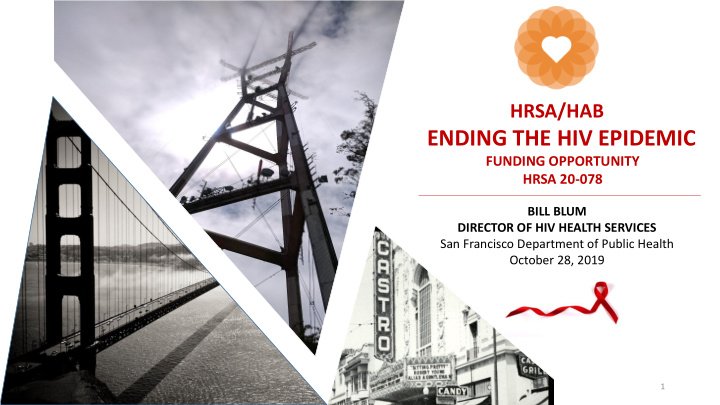



HRSA/HAB ENDING THE HIV EPIDEMIC FUNDING OPPORTUNITY HRSA 20-078 BILL BLUM DIRECTOR OF HIV HEALTH SERVICES San Francisco Department of Public Health October 28, 2019 1
SUMMARY This HRSA HAB initiative is authorized under Section 311(c) of the Public Health Service Act , (42 U.S.C. § 243(c)) and title XXVI, (42 U.S.C. § 300ff-11 et seq.), with the funding to be used in conjunction with the RWHAP . As such, there is the opportunity for RWHAP programs funded under this announcement (NOFO HRSA 20-078) to have a broader approach to addressing HIV in their communities . 2
ETHE PLAN FOR HIV CARE This 10-year initiative beginning FY 2020 seeks to achieve the important goal of reducing new HIV infections in the United States to less than 3,000 per year by 2030 . 3
ETHE PLAN FOR HIV CARE The first phase of the initiative will focus $170M Additional Other HIV $291M FY-2020 ETHE Funding on 48 counties, Washington DC, San Funding beyond ETHE Juan, Puerto Rico, and 7 states with a CDC – $140M HRSA MAI - $54M substantial rural HIV burden HRSA Ryan White - $70M SAMHSA MAI - $116M HRSA Health Clinics - $50M Indian Health - $25M NIH - $6M 4
APPLICATION BACKGROUND The National HIV/AIDS Strategy for the United States: Updated to 2020 (NHAS 2020) is a 5-year plan (with the possibility for an additional 5 years) that details principles, priorities, and actions to guide the national response to the HIV epidemic. Activities funded by RWHAP focus on addressing these FOUR GOALS : 1) Reduce new HIV infections 2) Increase access to care and improve health outcomes for people with HIV 3) Reduce HIV-related health disparities and health inequities 4) Achieve a more coordinated national response. 5
ETHE KEY STRATEGIES DIAGNOSE TREAT PREVENT RESPOND Diagnose all individuals with HIV as early as possible. Approximately 165,000 Americans are living with HIV but don’t know they have it. Early detection is critical and can lead to quicker results in treatment and prevent transmission to others. Using the latest diagnostics and advanced automation systems, ETHE will make HIV testing simple, accessible, routine, and will connect people with HIV immediately to care. 6
ETHE KEY STRATEGIES TREAT DIAGNOSE PREVENT RESPOND Treat people rapidly and effectively to reach sustained viral suppression. People with HIV who take medication as prescribed and stay virally suppressed can live long, healthy lives and have effectively no risk of sexually transmitting HIV to a partner. 80% of annual new infections are transmitted by those living with HIV who are not receiving HIV care and treatment. ETHE will establish and expand programs to follow up with people with HIV no longer receiving care — and provide the resources needed to re-engage them in effective HIV care and treatment. 7
ETHE KEY STRATEGIES PREVENT DIAGNOSE TREAT RESPOND Prevent new HIV transmissions by using proven interventions • PrEP and syringe services programs (SSPs). Of the estimated 1 million Americans at substantial risk for HIV and who could benefit from PrEP, less than 1 in 4 are actually using this medication. Nearly 30 years of research has shown that comprehensive SSPs are safe, effective, and cost-saving, do not increase illegal drug use or crime, and play an important role in reducing the transmission of viral hepatitis, HIV and other infections. 8
ETHE KEY STRATEGIES RESPOND DIAGNOSE TREAT PREVENT Respond quickly to potential HIV outbreaks New laboratory methods and epidemiological techniques allow us to see where HIV may be spreading most rapidly, thereby allowing CDC and other partners to quickly develop and implement strategies to stop ongoing transmission. We will work with impacted communities to ensure they have the technology, personnel, and prevention resources to follow up on all HIV cases and to intervene to stop chains of transmission, and to get those impacted into appropriate care and treatment. 9
BUILDING ON THE WORK THAT’S ALREADY BEEN DONE BLACK & AFRICAN AMERICAN HEALTH INITIATIVE 10
SAN FRANCISCO APPLICATION RWHAP PART A EMA/TGA HIV HIGH BURDEN COUNTY August 18, 2019 San Francisco EMA, CA San Francisco County, CA – NOFO Release Date TIER 2 CEILING: $ 4,000,000 / MINIMUM: $ 750,000 October 15, 2019 San Francisco EMA, CA – NOFO Due Date HHS IS APPLYING FOR $ 4,000,000 HRSA IS ENCOURAGING INNOVATIVE PROGRAMS THAT ARE March 1, 2020 – LESS RESTRICTIVE THAN PROGRAM IS CURRENTLY DESIGNED Program Start • ONLY AN HIV DIAGNOSIS IS REQUIRED Date • NO SERVICE CATEGORY LIMITATIONS • FUNDER OF LAST RESORT REMAINS A REQUIREMENT • HRSA LOOKING FOR A 75% REDUCTION IN NEW HIV CASES 11
SAN FRANCISCO APPLICATION SIX POPULATIONS OF FOCUS HRSA applicants must describe how proposed activities will address Pillar Two (Treat), including: People who are Experiencing Homelessness Expanding access to HIV care and treatment in the focus jurisdictions for people with HIV, both those who are newly diagnosed and those who are not engaged in care, and/or not People who Use Drugs virally suppressed; and Individuals who are Incarcerated or have Addressing unmet needs and improving client-level health outcomes. been Recently Black / African Americans Latino/x Men who have sex with Men Trans Women 12
SAN FRANCISCO APPLICATION SERVICES IN THE APPLICATION INCLUDED Expanded services for people Expanded CoE & Non-CoE community- Enhanced psychiatric consultation experiencing homelessness based services Expanded administrative support for HIV Augmented post-incarceration Expanded mental health services Health Services navigation Enhanced and expanded ICM programs Expanded housing case management Innovative status-neutral access points Innovative Black & African American Expansion of Primary Medical Care Expanded street based services service delivery programs during off hours and weekends Tele-psychiatry support LINCS Expansion of peer to peer support Peer support to HIV-positive Trans Long-term injectable ART Expanded stabilization rooms Women INPUT GAINED FROM MULTIPLE FORUMS AND INTERVIEWS WITH OVER 30 SUBJECT MATTER EXPERTS, INCLUDING CONSUMERS, HCPC CO-CHAIRS, PROVIDERS, SFDPH HIV LEADERSHIP, HIV COMMUNITY PROVIDER 13 ORGANIZATIONS, GTZ LEADERSHIP & HIV RESEARCHERS
COMMENTS & QUESTIONS 14
Recommend
More recommend